List of birds of Yellowstone National Park
This list of birds of Yellowstone National Park includes every wild bird species reported in Yellowstone National Park in the last 50 years. Since its creation in March, 1872, 318 species of birds have been documented in the park.[1]
Only birds that are considered to have established, self-sustaining, wild populations in Yellowstone are included on this list. This means that birds that are considered probable escapees, although they may have been sighted flying free in Yellowstone, are not included. This list is presented in taxonomic order and follows The Check-list of North American Birds (7th edition, 1998) published by the American Ornithologists' Union. The family accounts at the beginning of each heading reflect this taxonomy, as do the species counts found in each family account.[2]
Legend
As listed in the Checklist of the Birds of Yellowstone National Park:[1]
- I - Introduced species that are not native to North America, but were brought to this continent by humans.
- B - Breeders, species known to have nested or produced dependent young in Yellowstone in recent years.
- * - Less than 20 documented records of this species exist in Yellowstone over the last 50 years.
- + - The Yellowstone Center For Resources welcomes additional information regarding this species.
- N - Neotropical migrants, birds known to spend the summer season in temperate North America and winter in the Neotropics (i.e., the area of the New World that lies south of Central Mexico and Cuba and north of northern Argentina and southern Brazil).
Ducks, geese and swans

Order: Anseriformes Family: Anatidae
The family Anatidae includes the ducks and most duck-like waterfowl, such as geese and swans. These birds are adapted to an aquatic existence with webbed feet, bills which are flattened to a greater or lesser extent, and feathers that are excellent at shedding water due to special oils. There are 35 Yellowstone species.[2]
| Common name | Binomial | Status |
|---|---|---|
| Greater white-fronted goose | Anser albifrons | *N |
| Snow goose | Chen caerulescens | + |
| Ross's goose | Chen rossii | * |
| Brant | Branta bernicla | * |
| Canada goose | Branta canadensis | B |
| Cackling goose | Branta hutchinsii | |
| Trumpeter swan | Cygnus buccinator | B |
| Whooper swan | Cygnus cygnus | * |
| Wood duck | Aix sponsa | * |
| Gadwall | Anas strepera | BN |
| Eurasian wigeon | Anas penelope | * |
| American wigeon | Anas americana | BN |
| American black duck | Anas rubripes | * |
| Mallard | Anas platyrhynchos | BN |
| Blue-winged teal | Anas discors | BN |
| Cinnamon teal | Anas cyanoptera | BN |
| Northern shoveler | Anas clypeata | BN |
| Northern pintail | Anas acuta | BN |
| Green-winged teal | Anas crecca | BN |
| Canvasback | Aythya valisineria | BN |
| Redhead | Aythya americana | BN |
| Ring-necked duck | Aythya collaris | BN |
| Greater scaup | Aythya marila | * |
| Lesser scaup | Aythya affinis | BN |
| Harlequin duck | Histrionicus histrionicus | B |
| Surf scoter | Melanitta perspicillata | * |
| White-winged scoter | Melanitta fusca | * |
| Black scoter | Melanitta americana | * |
| Long-tailed duck | Clangula hyemalis | * |
| Bufflehead | Bucephala albeola | BN |
| Barrow's goldeneye | Bucephala islandica | B |
| Hooded merganser | Lophodytes cucullatus | + |
| Common merganser | Mergus merganser | B |
| Red-breasted merganser | Mergus serrator | +N |
| Ruddy duck | Oxyura jamaicensis | BN |
Partridges, grouse, turkeys and quail
Order: Galliformes Family: Phasianidae
Phasianidae consists of the pheasants and their allies. These are terrestrial species, variable in size but generally plump with broad relatively short wings. Many species are gamebirds or have been domesticated as a food source for humans. There are 5 Yellowstone species.[2]
| Common name | Binomial | Status |
|---|---|---|
| Chukar | Alectoris chukar | *I |
| Gray partridge | Perdix perdix | B+I |
| Ruffed grouse | Bonasa umbellus | B |
| Dusky grouse | Dendragapus obscurus | B |
| Wild turkey | Meleagris galopavo | * |
Loons
Order: Gaviiformes Family: Gaviidae
Loons are aquatic birds the size of a large duck, to which they are unrelated. Their plumage is largely gray or black, and they have spear-shaped bills. Loons swim well and fly adequately, but are almost hopeless on land, because their legs are placed towards the rear of the body. There are 3 Yellowstone species.[2]
| Common name | Binomial | Status |
|---|---|---|
| Red-throated loon | Gavia stellata | * |
| Pacific loon | Gavia pacifica | + |
| Common loon | Gavia immer | B |
Grebes
Order: Podicipediformes Family: Podicipedidae
Grebes are small to medium-large freshwater diving birds. They have lobed toes and are excellent swimmers and divers. However, they have their feet placed far back on the body, making them quite ungainly on land. There are 6 Yellowstone species.[2]
| Common name | Binomial | Status |
|---|---|---|
| Pied-billed grebe | Podilymbus podiceps | BN |
| Horned grebe | Podiceps auritus | +N |
| Red-necked grebe | Podiceps grisegena | B+ |
| Eared grebe | Podiceps nigricollis | B |
| Western grebe | Aechmophorus occidentalis | N |
| Clark's grebe | Aechmophorus clarkii | *N |
Cormorants
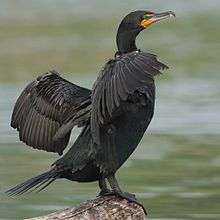
Order: Suliformes Family: Phalacrocoracidae
Cormorants are medium-to-large aquatic birds, usually with mainly dark plumage and areas of colored skin on the face. The bill is long, thin and sharply hooked. Their feet are four-toed and webbed, a distinguishing feature among the Pelecaniformes order. There is 1 Yellowstone species.[2]
| Common name | Binomial | Status |
|---|---|---|
| Double-crested cormorant | Phalacrocorax auritus | B |
Pelicans
Order: Pelecaniformes Family: Pelecanidae
Pelicans are very large water birds with a distinctive pouch under their beak. Like other birds in the order Pelecaniformes, they have four webbed toes. There is 1 Yellowstone species.[2]
| Common name | Binomial | Status |
|---|---|---|
| American white pelican | Pelecanus erythrorhynchos | BN |
Bitterns, herons and egrets
Order: Pelecaniformes Family: Ardeidae
The family Ardeidae contains the herons, egrets and bitterns. Herons and egrets are medium to large wading birds with long necks and legs. Bitterns tend to be shorter necked and more secretive. Members of Ardeidae fly with their necks retracted, unlike other long-necked birds such as storks, ibises and spoonbills. There are eight Yellowstone species.[2]
| Common name | Binomial | Status |
|---|---|---|
| American bittern | Botaurus lentiginosus | B*N |
| Great blue heron | Ardea herodias | B |
| Great egret | Ardea alba | *N |
| Snowy egret | Egretta thula | *N |
| Tricolored heron | Egretta tricolor | *N |
| Cattle egret | Bubulcus ibis | *N |
| Green heron | Butorides virescens | *N |
| Black-crowned night heron | Nycticorax nycticorax | *N |
Ibises and spoonbills
Order: Pelecaniformes Family: Threskiornithidae
The family Threskiornithidae includes the ibises and spoonbills. They have long, broad wings. Their bodies tend to be elongated, the neck more so, with rather long legs. The bill is also long, decurved in the case of the ibises, straight and distinctively flattened in the spoonbills. There are two Yellowstone species.[2]
| Common name | Binomial | Status |
|---|---|---|
| Glossy ibis | Plegadis falcinellus | * |
| White-faced ibis | Plegadis chihi | *N |
Storks
Order: Ciconiiformes Family: Ciconiidae
Storks are large, heavy, long-legged, long-necked wading birds with long stout bills and wide wingspans. They lack the powder down that other wading birds such as herons, spoonbills and ibises use to clean off fish slime. Storks lack a pharynx and are mute. There is 1 Yellowstone species.[2]
| Common name | Binomial | Status |
|---|---|---|
| Wood stork | Mycteria americana | *N |
New World vultures
Order: Cathartiformes Family: Cathartidae
The New World vultures are not closely related to Old World vultures, but superficially resemble them because of convergent evolution. Like the Old World vultures, they are scavengers, however, unlike Old World vultures, which find carcasses by sight, New World vultures have a good sense of smell with which they locate carcasses. There is 1 Yellowstone species.[2]
| Common name | Binomial | Status |
|---|---|---|
| Turkey vulture | Cathartes aura | +N |
Osprey
Order: Accipitriformes Family: Pandionidae
| Common name | Binomial | Status |
|---|---|---|
| Osprey | Pandion haliaetus | BN |
Hawks, kites and eagles
Order: Accipitriformes Family: Accipitridae
Accipitridae is a family of birds of prey, which includes hawks, eagles, kites, harriers and Old World vultures. These birds have very large powerful hooked beaks for tearing flesh from their prey, strong legs, powerful talons and keen eyesight. There are 13 Yellowstone species.[2]
| Common name | Binomial | Status |
|---|---|---|
| Bald eagle | Haliaeetus leucocephalus | B |
| Northern harrier | Circus cyaneus | BN |
| Sharp-shinned hawk | Accipiter striatus | BN |
| Cooper's hawk | Accipiter cooperii | BN |
| Northern goshawk | Accipiter gentilis | BN |
| Red-shouldered hawk | Buteo lineatus | *N |
| Broad-winged hawk | Buteo platypterus | *N |
| Swainson's hawk | Buteo swainsoni | BN |
| Red-tailed hawk | Buteo jamaicensis | BN |
| Ferruginous hawk | Buteo regalis | +N |
| Rough-legged hawk | Buteo lagopus | + |
| Golden eagle | Aquila chrysaetos | B* |
Caracaras and falcons
Order: Falconiformes Family: Falconidae
Falconidae is a family of diurnal birds of prey, notably the falcons and caracaras. They differ from hawks, eagles and kites in that they kill with their beaks instead of their talons. There are 5 Yellowstone species.[2]
| Common name | Binomial | Status |
|---|---|---|
| Crested caracara | Caracara cheriway | * |
| American kestrel | Falco sparverius | BN |
| Merlin | Falco columbarius | +N |
| Gyrfalcon | Falco rusticolus | BN |
| Prairie falcon | Falco mexicanus | BN |
Rails, gallinules and coots
Order: Gruiformes Family: Rallidae
Rallidae is a large family of small to medium-sized birds which includes the rails, crakes, coots and gallinules. The most typical family members occupy dense vegetation in damp environments near lakes, swamps or rivers. In general they are shy and secretive birds, making them difficult to observe. Most species have strong legs and long toes which are well adapted to soft uneven surfaces. They tend to have short, rounded wings and tend to be weak fliers. There are 4 Yellowstone species.[2]
| Common name | Binomial | Status |
|---|---|---|
| Yellow rail | Coturnicops noveboracensis | * |
| Virginia rail | Rallus limicola | B* |
| Sora | Porzana carolina | B |
| American coot | Fulica americana | B |
Cranes
Order: Gruiformes Family: Gruidae
Cranes are large, long-legged and long-necked birds. Unlike the similar-looking but unrelated herons, cranes fly with necks outstretched, not pulled back. Most have elaborate and noisy courting displays or "dances". There are 2 Yellowstone species.[2]
| Common name | Binomial | Status |
|---|---|---|
| Sandhill crane | Grus canadensis | B |
| Whooping crane | Grus americana | + |
Lapwings and plovers
Order: Charadriiformes Family: Charadriidae
The family Charadriidae includes the plovers, dotterels and lapwings. They are small to medium-sized birds with compact bodies, short, thick necks and long, usually pointed, wings. They are found in open country worldwide, mostly in habitats near water. There are 4 Yellowstone species.[2]
| Common name | Binomial | Status |
|---|---|---|
| Black-bellied plover | Pluvialis squatarola | * |
| Snowy plover | Charadrius nivosus | * |
| Semipalmated plover | Charadrius semipalmatus | * |
| Killdeer | Charadrius vociferus | BN |
Stilts and avocets
Order: Charadriiformes Family: Recurvirostridae
Recurvirostridae is a family of large wading birds, which includes the avocets and stilts. The avocets have long legs and long up-curved bills. The stilts have extremely long legs and long, thin, straight bills. There is 1 Yellowstone species.[2]
| Common name | Binomial | Status |
|---|---|---|
| Black-necked stilt | Himantopus mexicanus | * |
Sandpipers, curlews, stints, godwits, snipes and phalaropes
Order: Charadriiformes Family: Scolopacidae
Scolopacidae is a large diverse family of small to medium-sized shorebirds including the sandpipers, curlews, godwits, shanks, tattlers, woodcocks, snipes, dowitchers and phalaropes. The majority of these species eat small invertebrates picked out of the mud or soil. Different lengths of legs and bills enable multiple species to feed in the same habitat, particularly on the coast, without direct competition for food. There are 23 Yellowstone species.[2]
| Common name | Binomial | Status |
|---|---|---|
| Greater yellowlegs | Tringa melanoleuca | + |
| Lesser yellowlegs | Tringa flavipes | + |
| Solitary sandpiper | Tringa solitaria | + |
| Willet | Tringa semipalmata | + |
| Wandering tattler | Tringa incana | * |
| Spotted sandpiper | Actitis macularia | B |
| Upland sandpiper | Bartramia longicauda | *N |
| Long-billed curlew | Numenius americanus | B+N |
| Hudsonian godwit | Limosa haemastica | * |
| Marbled godwit | Limosa fedoa | + |
| Ruddy turnstone | Arenaria interpres | * |
| Red knot | Calidris canutus | * |
| Sanderling | Calidris alba | * |
| Semipalmated sandpiper | Calidris pusilla | * |
| White-rumped sandpiper | Calidris fuscicollis | * |
| Pectoral sandpiper | Calidris melanotos | * |
| Dunlin | Calidris alpina | * |
| Stilt sandpiper | Calidris himantopus | * |
| Short-billed dowitcher | Limnodromus griseus | * |
| Long-billed dowitcher | Limnodromus scolopaceus | + |
| Wilson's snipe | Gallinago delicata | B |
| Wilson's phalarope | Phalaropus tricolor | B+ |
| Red-necked phalarope | Phalaropus lobatus | * |
Gulls, terns and skimmers
Order: Charadriiformes Family: Laridae
Laridae is a family of medium to large seabirds and includes jaegers, skuas, gulls, terns, kittiwakes and skimmers. They are typically gray or white, often with black markings on the head or wings. They have stout, longish bills and webbed feet. There are 13 Yellowstone species.[2]
| Common name | Binomial | Status |
|---|---|---|
| Sabine's gull | Xema sabini | * |
| Laughing gull | Larus atricilla | * |
| Bonaparte's gull | Larus philadelphia | * |
| Franklin's gull | Larus pipixcan | + |
| Mew gull | Larus canus | * |
| California gull | Larus californicus | B |
| Herring gull | Larus argentatus | * |
| Caspian tern | Hydroprogne caspia | B |
| Black tern | Chlidonias niger | B+ |
| Common tern | Sterna hirundo | * |
| Arctic tern | Sterna paradisaea | * |
| Forster's tern | Sterna forsteri | * |
Skuas
Order: Charadriiformes Family: Stercorariidae
| Common name | Binomial | Status |
|---|---|---|
| Parasitic jaeger | Stercorarius parasiticus | * |
Auks, murres and puffins
Order: Charadriiformes Family: Alcidae
The family Alcidae includes auks, murres and puffins. These are short winged birds that live on the open sea and normally only come ashore for breeding. There is 1 Yellowstone species.[2]
| Common name | Binomial | Status |
|---|---|---|
| Long-billed murrelet | Brachyramphus perdix | * |
Pigeons and doves
Order: Columbiformes Family: Columbidae
Pigeons and doves are stout-bodied birds with short necks and short slender bills with a fleshy cere. There are 3 Yellowstone species.[2]
| Common name | Binomial | Status |
|---|---|---|
| Rock pigeon | Columba livia | IB |
| Band-tailed pigeon | Patagioenas fasciata | *N |
| Mourning dove | Zenaida macroura | B+N |
Cuckoos, roadrunners and anis
Order: Cuculiformes Family: Cuculidae
The family Cuculidae includes cuckoos, roadrunners and anis. These birds are of variable size with slender bodies, long tails and strong legs. There is 1 Yellowstone species.[2]
| Common name | Binomial | Status |
|---|---|---|
| Black-billed cuckoo | Coccyzus erythropthalmus | *N |
Barn owls
Order: Strigiformes Family: Tytonidae
Barn owls are medium to large owls with large heads and characteristic heart-shaped faces. They have long strong legs with powerful talons. There is 1 Yellowstone species.[2]
| Common name | Binomial | Status |
|---|---|---|
| Barn owl | Tyto alba | * |
True owls
Order: Strigiformes Family: Strigidae
Typical owls are small to large solitary nocturnal birds of prey. They have large forward-facing eyes and ears, a hawk-like beak and a conspicuous circle of feathers around each eye called a facial disk. There are 11 Yellowstone species.[2]
| Common name | Binomial | Status |
|---|---|---|
| Flammulated owl | Psiloscops flammeolus | * |
| Western screech-owl | Megascops kennicottii | * |
| Eastern screech-owl | Megascops asio | * |
| Great horned owl | Bubo virginianus | B |
| Northern pygmy-owl | Glaucidium gnoma | B+ |
| Burrowing owl | Athene cunicularia | +N |
| Great gray owl | Strix nebulosa | B+ |
| Long-eared owl | Asio otus | B*N |
| Short-eared owl | Asio flammeus | B*N |
| Boreal owl | Aegolius funereus | B+ |
| Northern saw-whet owl | Aegolius acadicus | B+ |
Nightjars
Order: Caprimulgiformes Family: Caprimulgidae
Nightjars are medium-sized nocturnal birds that usually nest on the ground. They have long wings, short legs and very short bills. Most have small feet, of little use for walking, and long pointed wings. Their soft plumage is cryptically colored to resemble bark or leaves. There is 1 Yellowstone species.[2]
| Common name | Binomial | Status |
|---|---|---|
| Common nighthawk | Chordeiles minor | B+N |
Swifts
Order: Apodiformes Family: Apodidae
The swifts are small birds which spend the majority of their lives flying. These birds have very short legs and never settle voluntarily on the ground, perching instead only on vertical surfaces. Many swifts have very long, swept-back wings which resemble a crescent or boomerang. There are 2 Yellowstone species.[2]
| Common name | Binomial | Status |
|---|---|---|
| Vaux's swift | Chaetura vauxi | *N |
| White-throated swift | Aeronautes saxatalis | BN |
Hummingbirds
Order: Apodiformes Family: Trochilidae
Hummingbirds are small birds capable of hovering in mid-air due to the rapid flapping of their wings. They are the only birds that can fly backwards. There are 3 Yellowstone species.[2]
| Common name | Binomial | Status |
|---|---|---|
| Calliope hummingbird | Selasphorus calliope | B+N |
| Broad-tailed hummingbird | Selasphorus platycercus | B+N |
| Rufous hummingbird | Selasphorus rufus | B+N |
Kingfishers
Order: Coraciiformes Family: Alcedinidae
Kingfishers are medium-sized birds with large heads, long, pointed bills, short legs and stubby tails. There is 1 Yellowstone species.[2]
| Common name | Binomial | Status |
|---|---|---|
| Belted kingfisher | Megaceryle alcyon | B |
Woodpeckers, sapsuckers and flickers
Order: Piciformes Family: Picidae
Woodpeckers are small to medium-sized birds with chisel-like beaks, short legs, stiff tails and long tongues used for capturing insects. Some species have feet with two toes pointing forward and two backward, while several species have only three toes. Many woodpeckers have the habit of tapping noisily on tree trunks with their beaks. There are 13 Yellowstone species.[2]
| Common name | Binomial | Status |
|---|---|---|
| Lewis's woodpecker | Melanerpes lewis | B+ |
| Red-headed woodpecker | Melanerpes erythrocephalus | * |
| Red-bellied woodpecker | Melanerpes carolinus | * |
| Williamson's sapsucker | Sphyrapicus thyroideus | B+N |
| Yellow-bellied sapsucker | Sphyrapicus varius | *N |
| Red-naped sapsucker | Sphyrapicus nuchalis | BN |
| Downy woodpecker | Picoides pubescens | B* |
| Hairy woodpecker | Picoides villosus | B |
| White-headed woodpecker | Picoides albolarvatus | * |
| American three-toed woodpecker | Picoides dorsalis | B+ |
| Black-backed woodpecker | Picoides arcticus | B+ |
| Northern flicker | Colaptes auratus | BN |
| Pileated woodpecker | Dryocopus pileatus | * |
Tyrant flycatchers
Order: Passeriformes Family: Tyrannidae
Tyrant flycatchers are Passerine birds which occur throughout North and South America. They superficially resemble the Old World flycatchers, but are more robust and have stronger bills. They do not have the sophisticated vocal capabilities of the songbirds. Most, but not all, are rather plain. As the name implies, most are insectivorous. There are 13 Yellowstone species.[2]
| Common name | Binomial | Status |
|---|---|---|
| Olive-sided flycatcher | Contopus cooperi | BN |
| Western wood-pewee | Contopus sordidulus | BN |
| Willow flycatcher | Empidonax traillii | B*N |
| Least flycatcher | Empidonax minimus | *N |
| Hammond's flycatcher | Empidonax hammondii | BN |
| Gray flycatcher | Empidonax wrightii | B*N |
| Dusky flycatcher | Empidonax oberholseri | BN |
| Cordilleran flycatcher | Empidonax occidentalis | B*N |
| Say's phoebe | Sayornis saya | *N |
| Ash-throated flycatcher | Myiarchus cinerascens | *N |
| Western kingbird | Tyrannus verticalis | *N |
| Eastern kingbird | Tyrannus tyrannus | +N |
| Scissor-tailed flycatcher | Tyrannus forficatus | * |
Shrikes
Order: Passeriformes Family: Laniidae
Shrikes are passerine birds known for their habit of catching other birds and small animals and impaling the uneaten portions of their bodies on thorns. A typical shrike's beak is hooked, like a bird of prey. There are 2 Yellowstone species.[2]
| Common name | Binomial | Status |
|---|---|---|
| Loggerhead shrike | Lanius ludovicianus | +N |
| Northern shrike | Lanius excubitor | + |
Vireos
Order: Passeriformes Family: Vireonidae
The vireos are a group of small to medium-sized passerine birds restricted to the New World. They are typically greenish in color and resemble wood warblers apart from their heavier bills. There are 5 Yellowstone species.[2]
| Common name | Binomial | Status |
|---|---|---|
| Blue-headed vireo | Vireo solitarius | *N |
| Yellow-throated vireo | Vireo flavifrons | *N |
| Warbling vireo | Vireo gilvus | BN |
| Philadelphia vireo | Vireo philadelphicus | *N |
| Red-eyed vireo | Vireo olivaceus | *N |
Jays, crows, magpies and ravens
Order: Passeriformes Family: Corvidae
The family Corvidae includes crows, ravens, jays, choughs, magpies, treepies, nutcrackers and ground jays. Corvids are above average in size among the Passeriformes, and some of the larger species show high levels of intelligence. There are 8 Yellowstone species.[2]
| Common name | Binomial | Status |
|---|---|---|
| Gray jay | Perisoreus canadensis | B |
| Steller's jay | Cyanocitta stelleri | B |
| Blue jay | Cyanocitta cristata | * |
| Pinyon jay | Gymnorhinus cyanocephalus | * |
| Clark's nutcracker | Nucifraga columbiana | B |
| Black-billed magpie | Pica hudsonia | B |
| American crow | Corvus brachyrhynchos | B |
| Common raven | Corvus corax | B |
Larks
Order: Passeriformes Family: Alaudidae
Larks are small terrestrial birds with often extravagant songs and display flights. Most larks are fairly dull in appearance. Their food is insects and seeds. There is 1 Yellowstone species.[2]
| Common name | Binomial | Status |
|---|---|---|
| Horned lark | Eremophila alpestris | BN |
Swallows and martins
Order: Passeriformes Family: Hirundinidae
The family Hirundinidae is adapted to aerial feeding. They have a slender streamlined body, long pointed wings and a short bill with a wide gape. The feet are adapted to perching rather than walking, and the front toes are partially joined at the base. There are 6 Yellowstone species.[2]
| Common name | Binomial | Status |
|---|---|---|
| Tree swallow | Tachycineta bicolor | BN |
| Violet-green swallow | Tachycineta thalassina | BN |
| Northern rough-winged swallow | Stelgidopteryx serripennis | BN |
| Bank swallow | Riparia riparia | BN |
| Cliff swallow | Petrochelidon pyrrhonota | BN |
| Barn swallow | Hirundo rustica | BN |
Chickadees and titmice
Order: Passeriformes Family: Paridae
The Paridae are mainly small stocky woodland species with short stout bills. Some have crests. They are adaptable birds, with a mixed diet including seeds and insects. There are 2 Yellowstone species.[2]
| Common name | Binomial | Status |
|---|---|---|
| Black-capped chickadee | Poecile atricapilla | B+ |
| Mountain chickadee | Poecile gambeli | B |
Nuthatches
Order: Passeriformes Family: Sittidae
Nuthatches are small woodland birds. They have the unusual ability to climb down trees head first, unlike other birds which can only go upwards. Nuthatches have big heads, short tails and powerful bills and feet. There are 3 Yellowstone species.[2]
| Common name | Binomial | Status |
|---|---|---|
| Red-breasted nuthatch | Sitta canadensis | B |
| White-breasted nuthatch | Sitta carolinensis | B+ |
| Pygmy nuthatch | Sitta pygmaea | * |
Creepers
Order: Passeriformes Family: Certhiidae
Creepers are small woodland birds, brown above and white below. They have thin pointed down-curved bills, which they use to extricate insects from bark. They have stiff tail feathers, like woodpeckers, which they use to support themselves on vertical trees. There is 1 Yellowstone species.[2]
| Common name | Binomial | Status |
|---|---|---|
| Brown creeper | Certhia americana | B |
Wrens
Order: Passeriformes Family: Troglodytidae
Wrens are small and inconspicuous birds, except for their loud songs. They have short wings and thin down-turned bills. Several species often hold their tails upright. All are insectivorous. There are 6 Yellowstone species.[2]
| Common name | Binomial | Status |
|---|---|---|
| Rock wren | Salpinctes obsoletus | BN |
| Canyon wren | Catherpes mexicanus | * |
| House wren | Troglodytes aedon | BN |
| Winter wren | Troglodytes hiemalis | * |
| Sedge wren | Cistothorus platensis | *N |
| Marsh wren | Cistothorus palustris | *N |
Dippers
Order: Passeriformes Family: Cinclidae
Dippers are small, stout, birds that feed in cold, fast moving streams. There is 1 Yellowstone species.[2]
| Common name | Binomial | Status |
|---|---|---|
| American dipper | Cinclus mexicanus | B |
Kinglets
Order: Passeriformes Family: Regulidae
The kinglets are a small family of birds which resemble the titmice. They are very small insectivorous birds in the genus Regulus. The adults have colored crowns, giving rise to their names. There are 2 Yellowstone species.[2]
| Common name | Binomial | Status |
|---|---|---|
| Golden-crowned kinglet | Regulus satrapa | B+N |
| Ruby-crowned kinglet | Regulus calendula | BN |
Gnatcatchers
Order: Passeriformes Family: Polioptilidae
| Common name | Binomial | Status |
|---|---|---|
| Blue-gray gnatcatcher | Polioptila caerulea | *N |
Thrushes
Order: Passeriformes Family: Turdidae
The thrushes are a group of passerine birds that occur mainly but not exclusively in the Old World. They are plump, soft plumaged, small to medium-sized insectivores or sometimes omnivores, often feeding on the ground. Many have attractive songs. There are 8 Yellowstone species.[2]
| Common name | Binomial | Status |
|---|---|---|
| Western bluebird | Sialia mexicana | *N |
| Mountain bluebird | Sialia currucoides | BN |
| Townsend's solitaire | Myadestes townsendi | B |
| Veery | Catharus fuscescens | *N |
| Swainson's thrush | Catharus ustulatus | B+N |
| Hermit thrush | Catharus guttatus | BN |
| American robin | Turdus migratorius | BN |
| Varied thrush | Ixoreus naevius | * |
Mockingbirds and thrashers
Order: Passeriformes Family: Mimidae
The mimids are a family of passerine birds which includes thrashers, mockingbirds, tremblers and the New World catbirds. These birds are notable for their vocalization, especially their remarkable ability to mimic a wide variety of birds and other sounds heard outdoors. The species tend towards dull grays and browns in their appearance. There are 4 Yellowstone species.[2]
| Common name | Binomial | Status |
|---|---|---|
| Gray catbird | Dumetella carolinensis | *N |
| Northern mockingbird | Mimus polyglottos | *N |
| Sage thrasher | Oreoscoptes montanus | BN |
| Brown thrasher | Toxostoma rufum | * |
Starlings
Order: Passeriformes Family: Sturnidae
Starlings are small to medium-sized passerine birds. They are medium-sized passerines with strong feet. Their flight is strong and direct and they are very gregarious. Their preferred habitat is fairly open country, and they eat insects and fruit. Plumage is typically dark with a metallic sheen. There is 1 Yellowstone species.[2]
| Common name | Binomial | Status |
|---|---|---|
| European starling | Sturnus vulgaris | IB |
Wagtails and pipits
Order: Passeriformes Family: Motacillidae
Motacillidae is a family of small passerine birds with medium to long tails. They include the wagtails, longclaws and pipits. They are slender, ground feeding insectivores of open country. There are 2 Yellowstone species.[2]
| Common name | Binomial | Status |
|---|---|---|
| American pipit | Anthus rubescens | BN |
| Sprague's pipit | Anthus spragueii | *N |
Waxwings
Order: Passeriformes Family: Bombycillidae
The waxwings are a group of passerine birds with soft silky plumage and unique red tips to some of the wing feathers. In the Bohemian and cedar waxwings, these tips look like sealing wax and give the group its name. These are arboreal birds of northern forests. They live on insects in summer and berries in winter. There is 1 Yellowstone species.[2]
| Common name | Binomial | Status |
|---|---|---|
| Cedar waxwing | Bombycilla cedrorum | B+N |
Silky-flycatchers
Order: Passeriformes Family: Ptiliogonatidae
The silky-flycatchers are a small family of passerine birds. The family is named for their silky plumage and their aerial flycatching techniques. They occur mainly in Central America from Panama to Mexico, with one species, the Phainopepla, extending northwards into the southwestern USA. They are mostly sedentary, but the Phainopepla is migratory over the northern part of its range.[2]
| Common name | Binomial | Status |
|---|---|---|
| Phainopepla | Phainopepla nitens | * |
Wood-warblers
Order: Passeriformes Family: Parulidae
The wood warblers are a group of small often colorful passerine birds restricted to the New World. Most are arboreal, but some like the ovenbird and the two waterthrushes, are more terrestrial. Most members of this family are insectivores. There are 23 Yellowstone species.[2]
| Common name | Binomial | Status |
|---|---|---|
| Tennessee warbler | Oreothlypis peregrina | *N |
| Orange-crowned warbler | Oreothlypis celata | B+N |
| Nashville warbler | Oreothlypis ruficapilla | * |
| Virginia's warbler | Oreothlypis virginiae | * |
| Yellow warbler | Setophaga petechia | BN |
| Chestnut-sided warbler | Setophaga pensylvanica | *N |
| Cape May warbler | Setophaga tigrina | *N |
| Yellow-rumped warbler | Setophaga coronata | BN |
| Townsend's warbler | Setophaga townsendi | *N |
| Blackburnian warbler | Setophaga fusca | *N |
| Yellow-throated warbler | Setophaga dominica | *N |
| Palm warbler | Setophaga palmarum | * |
| Bay-breasted warbler | Setophaga castanea | *N |
| Blackpoll warbler | Setophaga striata | *N |
| American redstart | Setophaga ruticilla | *N |
| Black-and-white warbler | Mniotilta varia | *N |
| Prothonotary warbler | Protonotaria citrea | *N |
| Ovenbird | Seiurus aurocapilla | *N |
| Northern waterthrush | Parkesia noveboracensis | B+N |
| MacGillivray's warbler | Geothlypis tolmiei | BN |
| Common yellowthroat | Geothlypis trichas | BN |
| Wilson's warbler | Cardellina pusilla | BN |
| Yellow-breasted chat | Icteria virens | *N |
Longspurs and snow buntings
Order: Passeriformes Family: Calcariidae
| Common name | Binomial | Status |
|---|---|---|
| McCown's longspur | Calcarius mccownii | *N |
| Lapland longspur | Calcarius lapponicus | * |
| Snow bunting | Plectrophenax nivalis | * |
American sparrows, towhees and juncos
Order: Passeriformes Family: Emberizidae
Emberizidae is a large family of passerine birds. They are seed-eating birds with distinctively shaped bills. In Europe, most species are called buntings. In North America, most of the species in this family are known as sparrows, but these birds are not closely related to the Old World sparrows which are in the family Passeridae. Many emberizid species have distinctive head patterns. There are 23 Yellowstone species.[2]
| Common name | Binomial | Status |
|---|---|---|
| Green-tailed towhee | Pipilo chlorurus | BN |
| Spotted towhee | Pipilo maculatus | *N |
| American tree sparrow | Spizelloides arborea | * |
| Chipping sparrow | Spizella passerina | BN |
| Clay-colored sparrow | Spizella pallida | *N |
| Brewer's sparrow | Spizella breweri | BN |
| Field sparrow | Spizella pusilla | * |
| Vesper sparrow | Pooecetes gramineus | BN |
| Black-chinned sparrow | Spizella atrogularis | *N |
| Lark sparrow | Chondestes grammacus | *N |
| Black-throated sparrow | Amphispiza bilineata | *N |
| Lark bunting | Calamospiza melanocorys | *N |
| Savannah sparrow | Passerculus sandwichensis | BN |
| Grasshopper sparrow | Ammodramus savannarum | *N |
| Le Conte's sparrow | Ammodramus leconteii | *N |
| Fox sparrow | Passerella iliaca | B*N |
| Song sparrow | Melospiza melodia | BN |
| Lincoln's sparrow | Melospiza lincolnii | BN |
| Swamp sparrow | Melospiza georgiana | * |
| White-throated sparrow | Zonotrichia albicollis | * |
| Harris's sparrow | Zonotrichia querula | * |
| White-crowned sparrow | Zonotrichia leucophrys | BN |
| Dark-eyed junco | Junco hyemalis | BN |
Cardinals and grosbeaks
Order: Passeriformes Family: Cardinalidae
The cardinals are a family of robust, seed-eating birds with strong bills. They are typically associated with open woodland. The sexes usually have distinct plumages. There are 6 Yellowstone species.[2]
| Common name | Binomial | Status |
|---|---|---|
| Scarlet tanager | Piranga olivacea | *N |
| Western tanager | Piranga ludoviciana | BN |
| Rose-breasted grosbeak | Pheucticus ludovicianus | *N |
| Black-headed grosbeak | Pheucticus melanocephalus | *N |
| Lazuli bunting | Passerina amoena | BN |
| Indigo bunting | Passerina cyanea | *N |
Icterids
Order: Passeriformes Family: Icteridae
The icterids are a group of small to medium-sized, often colorful passerine birds restricted to the New World and include the grackles, New World blackbirds and New World orioles. Most species have black as a predominant plumage color, often enlivened by yellow, orange or red. There are 9 Yellowstone species.[2]
| Common name | Binomial | Status |
|---|---|---|
| Bobolink | Dolichonyx oryzivorus | *N |
| Red-winged blackbird | Agelaius phoeniceus | BN |
| Western meadowlark | Sturnella neglecta | BN |
| Yellow-headed blackbird | Xanthocephalus xanthocephalus | BN |
| Brewer's blackbird | Euphagus cyanocephalus | BN |
| Common grackle | Quiscalus quiscula | * |
| Brown-headed cowbird | Molothrus ater | BN |
| Baltimore oriole | Icterus galbula | *N |
| Bullock's oriole | Icterus bullockii | *N |
Fringilline finches, cardueline finches and allies
Order: Passeriformes Family: Fringillidae
Finches are seed-eating passerine birds, that are small to moderately large and have a strong beak, usually conical and in some species very large. All have twelve tail feathers and nine primaries. These birds have a bouncing flight with alternating bouts of flapping and gliding on closed wings, and most sing well. There are 12 Yellowstone species.[2]
| Common name | Binomial | Status |
|---|---|---|
| Black rosy-finch | Leucosticte atrata | B |
| Pine grosbeak | Pinicola enucleator | B |
| Purple finch | Haemorhous purpureus | * |
| Cassin's finch | Haemorhous cassinii | BN |
| House finch | Haemorhous mexicanus | B+ |
| Red crossbill | Loxia curvirostra | B |
| White-winged crossbill | Loxia leucoptera | B+ |
| Common redpoll | Acanthis flammea | * |
| Pine siskin | Spinus pinus | BN |
| Lesser goldfinch | Spinus psaltria | * |
| American goldfinch | Spinus tristis | +N |
| Evening grosbeak | Coccothraustes vespertinus | + |
Old World sparrows
Order: Passeriformes Family: Passeridae
Old World sparrows are small passerine birds. In general, sparrows tend to be small plump brownish or grayish birds with short tails and short powerful beaks. Sparrows are seed eaters, but they also consume small insects. There is 1 Yellowstone species.[2]
| Common name | Binomial | Status |
|---|---|---|
| House sparrow | Passer domesticus | IB |
See also
Further reading
- Brodrick, Harold J. (1952). Birds of Yellowstone National Park: A Descriptive Check List of the Birds of Yellowstone with Helpful Illustrations. Yellowstone National Park.
- Zardus, Maurice J. (1967). Birds of Yellowstone and Grand Teton National Parks. Salt Lake City, UT: Wheelright Press.
- Follett, dick (1975). Birds of Yellowstone and Grand Teton National Parks. Yellowstone Library and Museum Association. ISBN 0911797149.
- Zarki, J.; Follett, R. (1987). A Checklist, Birds of Yellowstone National Park.
- McEneaney, Terry; McEneaney, Karen (1988). Birds of Yellowstone: a Practical Habitat Guide to the Birds of Yellowstone National Park- and Where to Find Them. Boulder, CO: Robert Rinehart Inc. ISBN 0911797440.
- Wilkinson, Todd (1992). Yellowstone Wildlife A Watcher's Guide. Minocqua, WI: NorthWord Press. ISBN 155971140X.
Annual Yellowstone Bird Reports
- McEneaney, Terry (1999). Yellowstone Bird Report 1999 (PDF) (Report). Yellowstone Center for Resources, National Park Service, Yellowstone National Park, Wyoming. YCR–NR–2000–02.
- McEneaney, Terry (2000). Yellowstone Bird Report 2000 (PDF) (Report). Yellowstone Center for Resources, National Park Service, Yellowstone National Park, Wyoming. YCR–NR–2001–01.
- McEneaney, Terry (2001). Yellowstone Bird Report 2001 (PDF) (Report). Yellowstone Center for Resources, National Park Service, Yellowstone National Park, Wyoming. YCR–NR–2002–03.
- McEneaney, Terry (2002). Yellowstone Bird Report 2002 (PDF) (Report). Yellowstone Center for Resources, National Park Service, Yellowstone National Park, Wyoming. YCR–NR–2003–03.
- McEneaney, Terry (2003). Yellowstone Bird Report 2003 (PDF) (Report). Yellowstone Center for Resources, National Park Service, Yellowstone National Park, Wyoming. YCR–NR–2004–01.
- McEneaney, Terry (2004). Yellowstone Bird Report 2004 (PDF) (Report). Yellowstone Center for Resources, National Park Service, Yellowstone National Park, Wyoming. YCR-2005-01.
- McEneaney, Terry (2005). Yellowstone Bird Report 2005 (PDF) (Report). Yellowstone Center for Resources, National Park Service, Yellowstone National Park, Wyoming. YCR-2006-2.
- McEneaney, Terry (2006). Yellowstone Bird Report 2006 (PDF) (Report). Yellowstone Center for Resources, National Park Service, Yellowstone National Park, Wyoming. YCR-2007-01.
Notes
- 1 2 McEneaney, Terry (April 2004). Field Checklist of the Birds of Yellowstone National Park (PDF) (Report). Yellowstone Center for Resource, Yellowstone National Park, National Park Service. Retrieved 2010-01-30.
- 1 2 3 4 5 6 7 8 9 10 11 12 13 14 15 16 17 18 19 20 21 22 23 24 25 26 27 28 29 30 31 32 33 34 35 36 37 38 39 40 41 42 43 44 45 46 47 48 49 50 51 52 53 "The AOU Check-list of North American Birds, 7th Edition". The American Ornithologists' Union. Retrieved 2011-02-04.




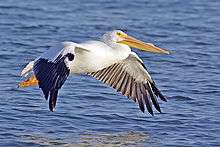


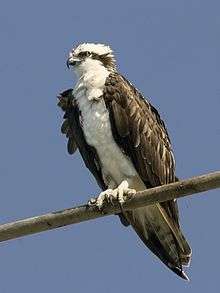






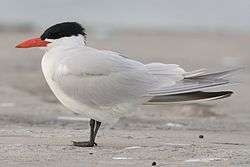


.jpg)


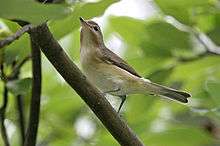




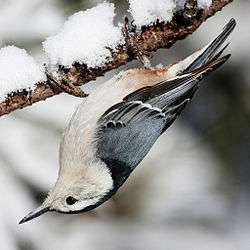



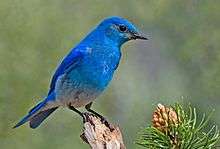

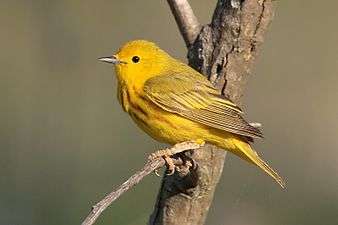



.jpg)
_(1).jpg)
